A Multi-Segment Expanded Anchor for Landslide Emergency Management
Abstract
:1. Introduction
2. MSEA Structure
3. Field Tests
3.1. Overview
3.2. Test Method
- (1)
- Preparing MSEAs. Figure 4 illustrates the assembly process of a MSEA during the field tests. The bearing blades are depicted in Figure 4a. Each load-bearing body is composed of four bearing blades, each of which has a guide rail at the end. An assembled load-bearing body is shown in Figure 4b. First, the anchor with a P-type anchorage passed through the sliding anchorage, and the guide rails at the ends of the bearing blades were inserted into the sliding groove reserved at the guide head. Then, the sliding anchorage was wrapped and surrounded by the blades. The surfaces of the blades were serrated to increase the frictional drag between the bearing blades and the perforated wall. Figure 4c shows a photo of a MSEA with a length of 23 m, that used two load-bearing bodies to share the pressure. To facilitate the installation of the MSEAs, a traction rope was used to pass through the load-bearing bodies.
- (2)
- Initial tensile tests. To determine the initial bearing capacity of the MSEAs without grouting, six MSEAs each with a length of 23 m were tested in the field without grouting.
- (3)
- Failure tests without grouting. The failure tests without grouting were conducted for MSEAs Nos. 4–6 to determine their ultimate bearing capacity without grouting. During loading, the two load-bearing bodies of each MSEA were cyclically stressed under the control of oil pressure in order to achieve uniform stress between them. Load-bearing bodies of each MSEA were tensioned successively under an oil pressure of 10 MPa and were then tensioned in sequence under an oil pressure of 12.5 MPa. In this way, a staged cyclic tension was performed.
- (4)
- Secondary tensile tests: Secondary tensile tests were conducted on MSEAs Nos. 1, 2, and 3 after mortar curing for 14 days, three days, and three days, respectively.
3.3. Analysis of Test Results
4. Calculation Method of the Ultimate Bearing Capacity of MSEAs
4.1. Initial Tension Process
- (1)
- Stage OA: The steel strands experienced pre-tension. The sliding anchorage moved relative to the load-bearing body. The bearing blades gradually expanded but were not in contact with the hole wall.
- (2)
- Stage AB: The bearing blades gradually expanded and pressed against the hole wall, causing friction.
- (3)
- Stage BC: The bearing blades were completely expanded and closely fitted onto the hole wall. The MSEA supported the load only by frictional drag along the hole wall.
- (4)
- Stage CD: The upper end of the load-bearing body was pressed against the lock in the upper part of the underream. The lock provided a reaction force in addition to the frictional drag between the blades and the hole wall.
4.2. Fundamental Assumptions
- (1)
- At stage BC, the tension is decomposed into two superimposed parts, namely the pressure of the bearing blades against the hole wall and the axial tension of the load-bearing bodies.
- (2)
- At stage BC, the contact pressure between the bearing blades and the hole wall is evenly distributed when the bearing blades expand and press the hole wall.
- (3)
- At stage BC, the rock masses of the hole wall are in the state of ultimate stress at the moment of slip. In other words, the sliding of the MSEA is caused by the tensile failure of the rock masses and not by the failure of the load-bearing body.
- (4)
- At stage CD, the upper end of the load-bearing body presses the lock in the upper part of the underream. The lock may generate a reaction force in addition to the frictional drag between the blades and the hole wall.
4.3. Ultimate Bearing Capacity at Stage BC of the MSEAs
4.4. Ultimate Bearing Capacity at Stage CD of the MSEAs
4.5. Verification
5. Conclusions
Author Contributions
Funding
Institutional Review Board Statement
Informed Consent Statement
Data Availability Statement
Conflicts of Interest
References
- Gao, C.; Xu, Q.; Peng, S. Application research of UAV photogrammetry technology in the emergency rescue of Baige landslide. J. Catastrophol. 2020, 35, 203–210. [Google Scholar]
- Deng, J.; Gao, Y.; Yu, Z.; Xie, H. Analysis on the formation mechanism and process of Baige landslides damming the upper reach of Jinshan River, China. Adv. Eng. Sci. 2019, 51, 9–16. [Google Scholar]
- Feng, W.; Zhang, G.; Bai, H.; Zhou, Y.; Xu, Q.; Zheng, G. A preliminary analysis of the formation mechanism and development tendency of the huge Baige landslide in Jinsha River on October 11, 2018. J. Eng. Geol. 2019, 27, 415–425. [Google Scholar]
- Kim, N.-K. Performance of Tension and Compression Anchors in Weathered Soil. J. Geotech. Geoenvironmental Eng. 2003, 129, 1138–1150. [Google Scholar] [CrossRef]
- Kim, N.-K.; Park, J.-S.; Kim, S.-K. Numerical simulation of ground anchors. Comput. Geotech. 2007, 34, 498–507. [Google Scholar] [CrossRef]
- Li, C.; Stillborg, B. Analytical models for rock bolts. Int. J. Rock Mech. Min. Sci. 1999, 36, 1013–1029. [Google Scholar] [CrossRef]
- Kim, H.; Rehman, H.; Ali, W.; Naji, A.M.; Kim, J.-J.; Kim, J.; Yoo, H. Classification of Factors Affecting the Performance of Fully Grouted Rock Bolts with Empirical Classification Systems. Appl. Sci. 2019, 9, 4781. [Google Scholar] [CrossRef] [Green Version]
- Yin, Y.; Li, T.Q.; Tang, J. Landslide reactivation and emergency stabilization on Danba county town in Sichuan province. Chin. J. Rock Mech. Eng. 2008, 27, 972–978. [Google Scholar]
- Fan, X.M.; Xu, Q.; Huang, R.Q. Dynamical optimal anchoring design and information construction of Danba landslide. Chin. J. Rock Mech. Eng. 2007, 26, 4139–4146. [Google Scholar]
- Lin, C.Y.; Pan, X.C. Application of anchorage engineering in landslide emergency rescue. Subgrade Eng. 2019, 2, 235–240. [Google Scholar]
- Yang, D.; Wang, Q.C.; Yan, J.F. Two rapid set anchor piers and their application in Phoenix Rock unstable slopes. J. Lanzhou Univ. Nat. Sci. 2015, 51, 847–854. [Google Scholar]
- Zhang, Y.; Wang, Q.; Yang, D.; Shi, S. The research and application of 500 kN pre-cast high strength concrete anchorage pier products. J. Eng. Geol. 2015, 23, 793–797. [Google Scholar]
- Song, J.; Wang, Q.C.; Cheng, Y.J. The research and application of steel anchorage block in geo-hazard quick anchoring. Sci. Technol. Eng. 2017, 17, 129–133. [Google Scholar]
- Liu, J.; Zhang, L.S.; Sun, T. Construction performance and long-term stability of self-expansion anchoring materials. J. Build. Mater. 2019, 22, 656–672. [Google Scholar]
- Li, L.J.; Zhou, Y.; Yang, Y.N. Study on the method for determining the limit content of expansion agent in anchor body of self-expanding bolt. Rock Soil Mech. 2010, 41, 3266–3277. [Google Scholar]
- Jia, X.Y.; Yue, D.C.; Li, M. Study on construction process of mechanical reamed anchor and its application. Geotech. Investig. Surv. 2017, 4, 18–21. [Google Scholar]
- Kerr, N. A self-burying anchor of considerable holding power. In Proceedings of the Annual Offshore Technology Conference, Houston, TX, USA, 3–6 May 1976. [Google Scholar]
- Wang, J.J.; Zhao, C.H.; Yao, G.Z. Application of earth anchor with squibbing in landslide control. Chin. J. Geotech. Eng. 1996, 18, 41–46. [Google Scholar]
- Zhong, L.; Gang, G.; Zhang, Y. Construction technology and engineering applications of capsule-type under-reamed ground anchor. Chin. J. Geotech. Eng. 2014, 36, 205–211. [Google Scholar]
- Liu, Z.; Zhang, C.; Zhang, Y.; Lu, M. Field test study of under-reamed ground anchorage with capsule in Ningbo area. Rock Soil Mech. 2018, 39, 295–301. [Google Scholar]
- Gang, G.; Zhong, L.; Li, Y.-K. Model test research on failure mechanism of underreamed ground anchor. Chin. J. Rock Mech. Eng. 2013, 32, 1677–1684. [Google Scholar]
- Mei, G.X.; Xu, M.; Song, L.H.; Zhou, F.; Zai, J.M. In-situ tests on new umbrella-shaped anti-float anchors. Chin. J. Geotech. Eng. 2010, 32, 892–896. [Google Scholar]
- Zhang, R.-J.; Zheng, J.-J.; Li, P.-Y.; Zhang, J.; Yu, S. A method for predicting mechanical behaviour of HPJG–Anchors–Part I: Mechanical characteristics and load transfer models. Comput. Geotech. 2012, 45, 62–73. [Google Scholar] [CrossRef]
- Tistel, J.; Grimstad, G.; Eiksund, G. Testing and modeling of cyclically loaded rock anchors. J. Rock Mech. Geotech. Eng. 2017, 9, 1010–1030. [Google Scholar] [CrossRef]
- Wang, T.; Chang, J.; Yin, Z.; Gong, P.; Shi, W.; Li, N. Theory and full-scale simulation testing of the mechanical properties of anchors under a variable lateral pressure coefficient. Arab. J. Geosci. 2021, 14, 136. [Google Scholar] [CrossRef]
- Liu, J.L. Pile Engineering Handbook; China Architecture and Building Press: Beijing, China, 1995; ISBN 9787112180721. [Google Scholar]
- Liu, W.B.; Zhou, J.; Temuer, M.K. Uplift tests and calculations of under-reamed piles. Ind. Constr. 2003, 33, 42–45. [Google Scholar]
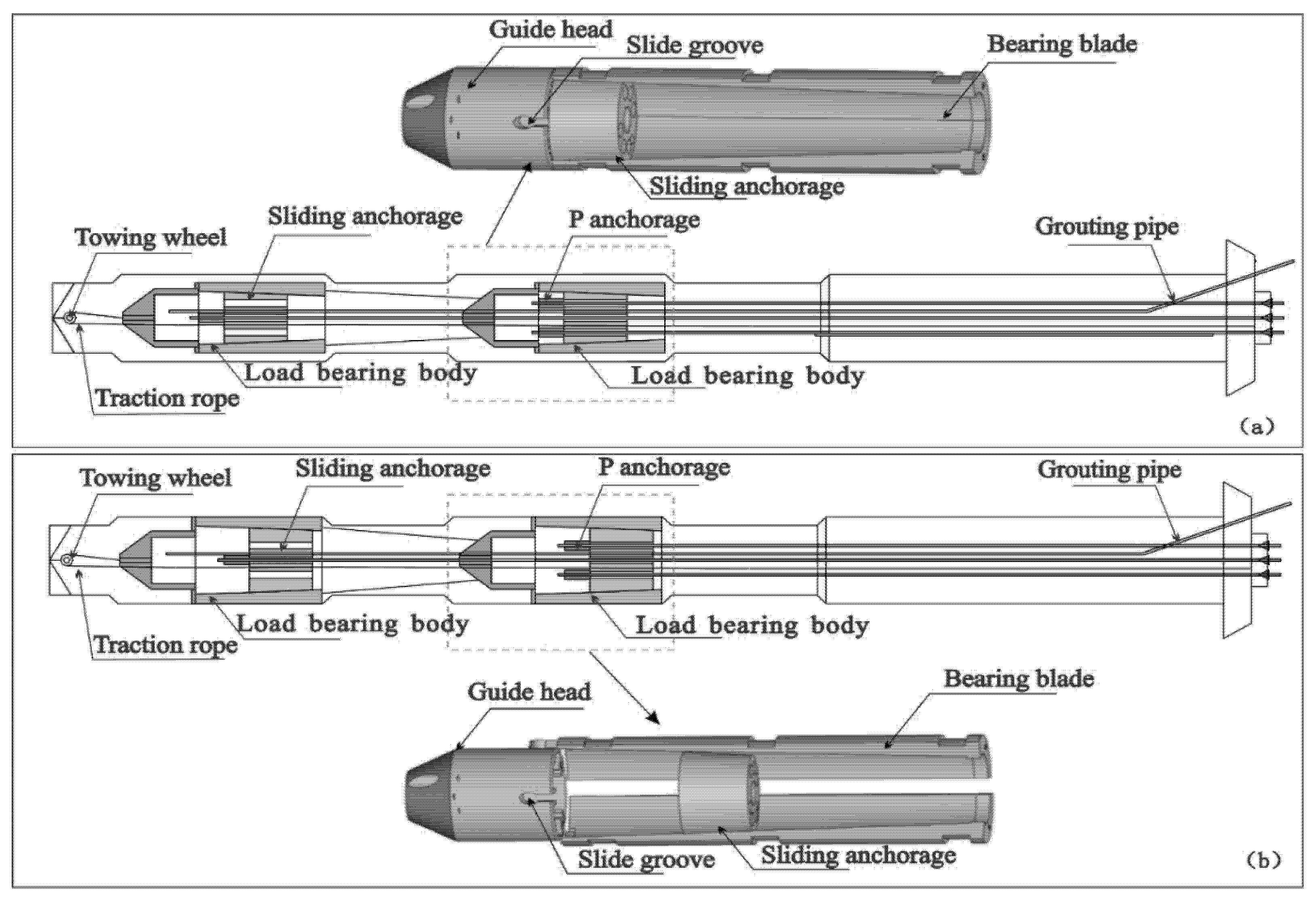
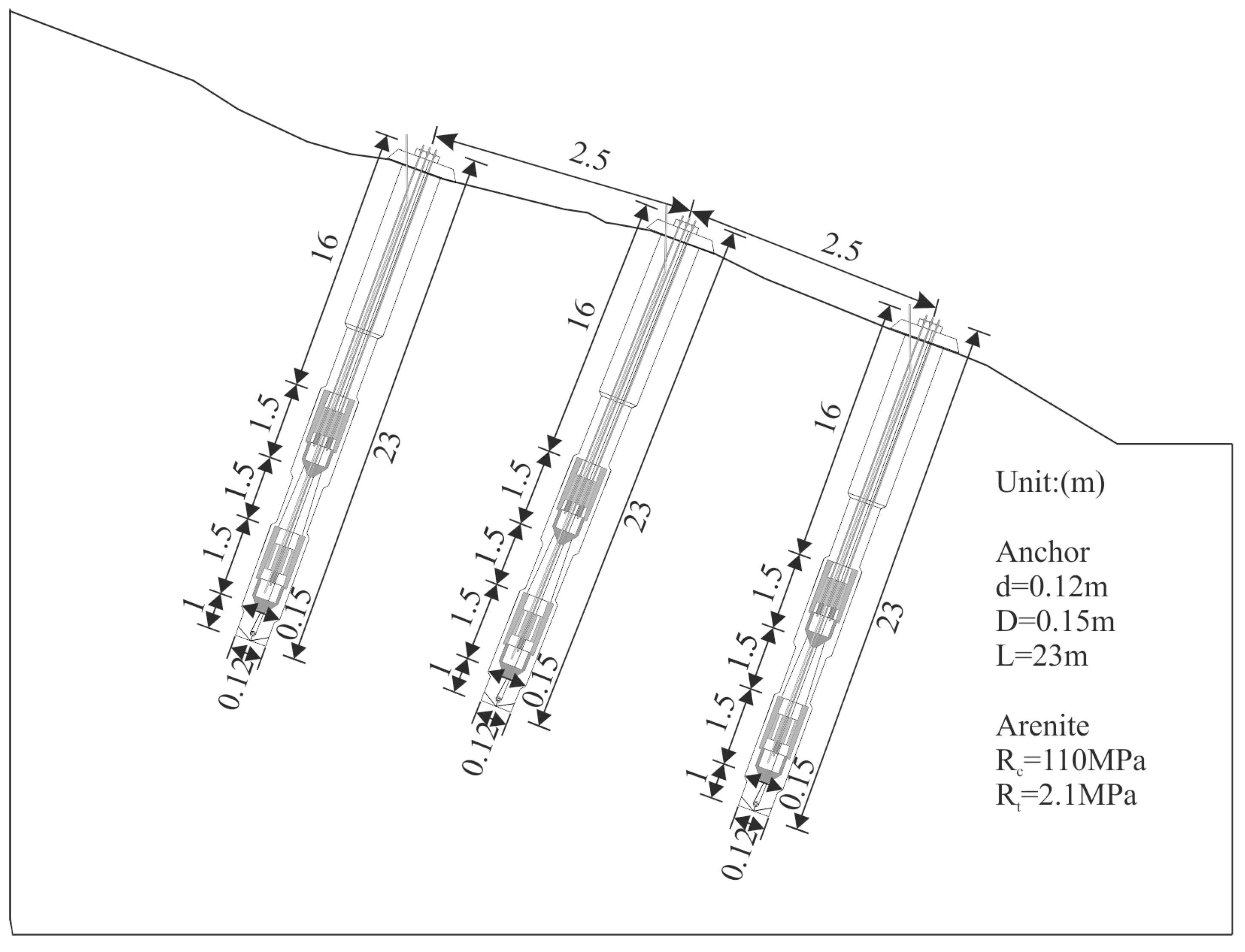
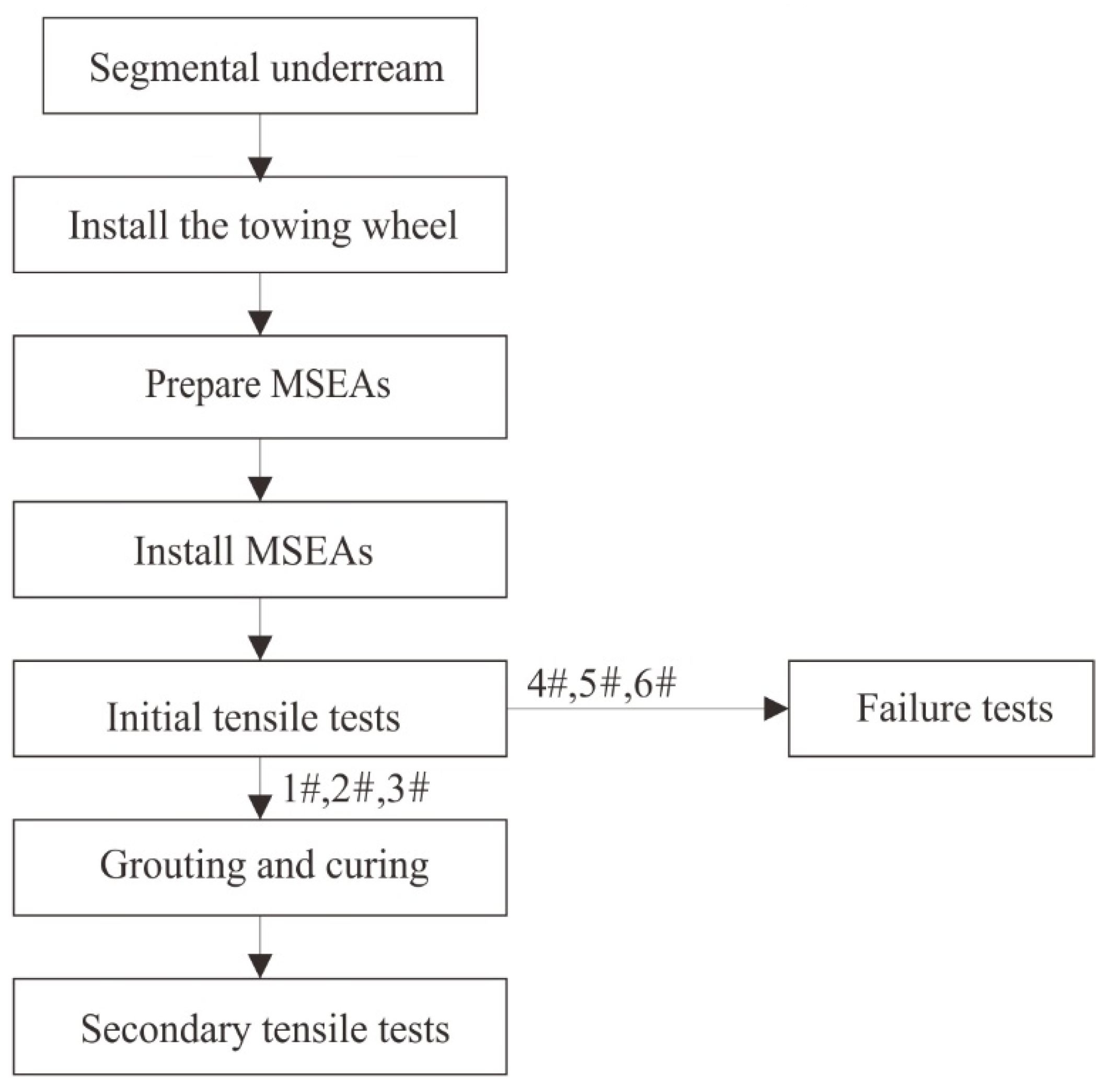
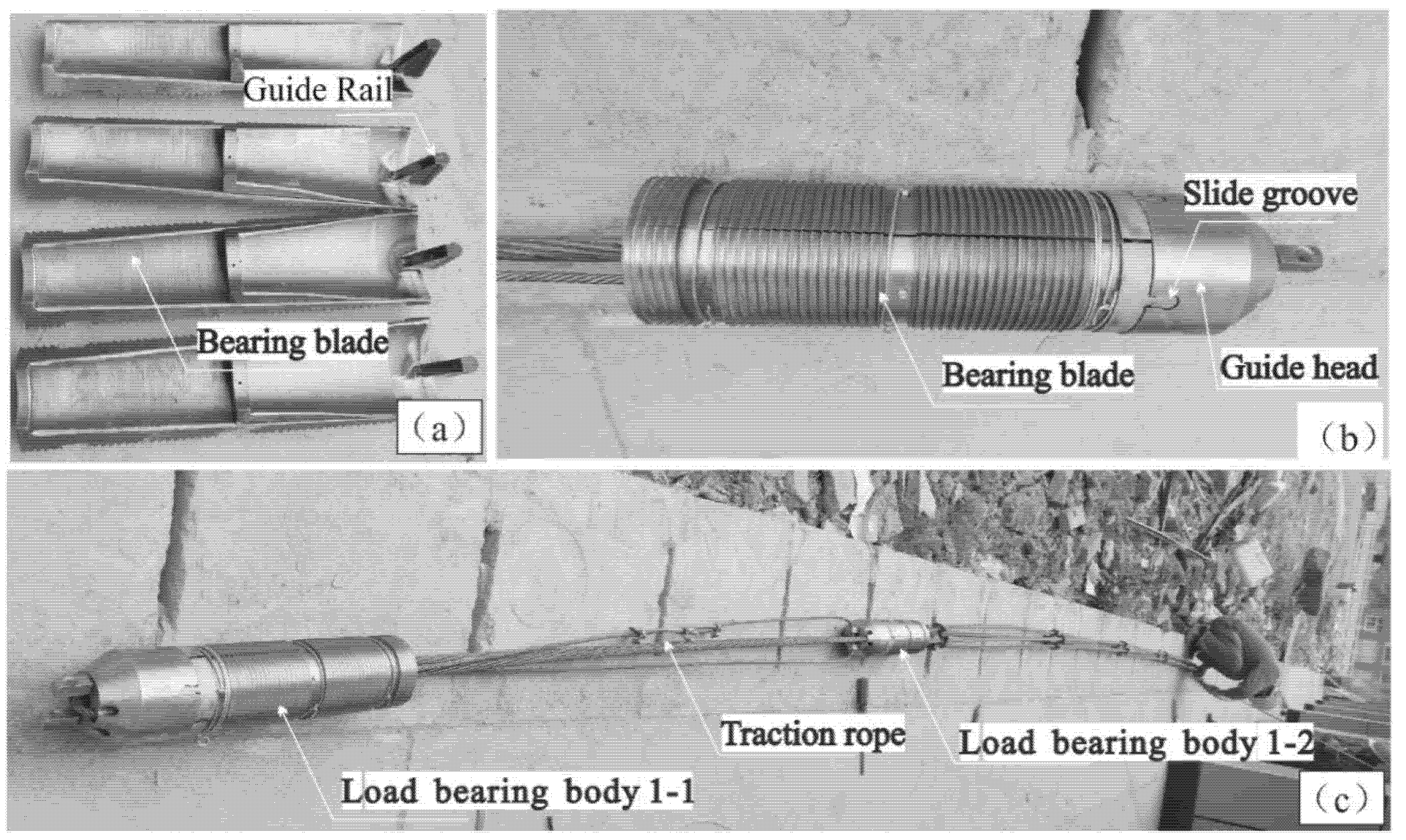

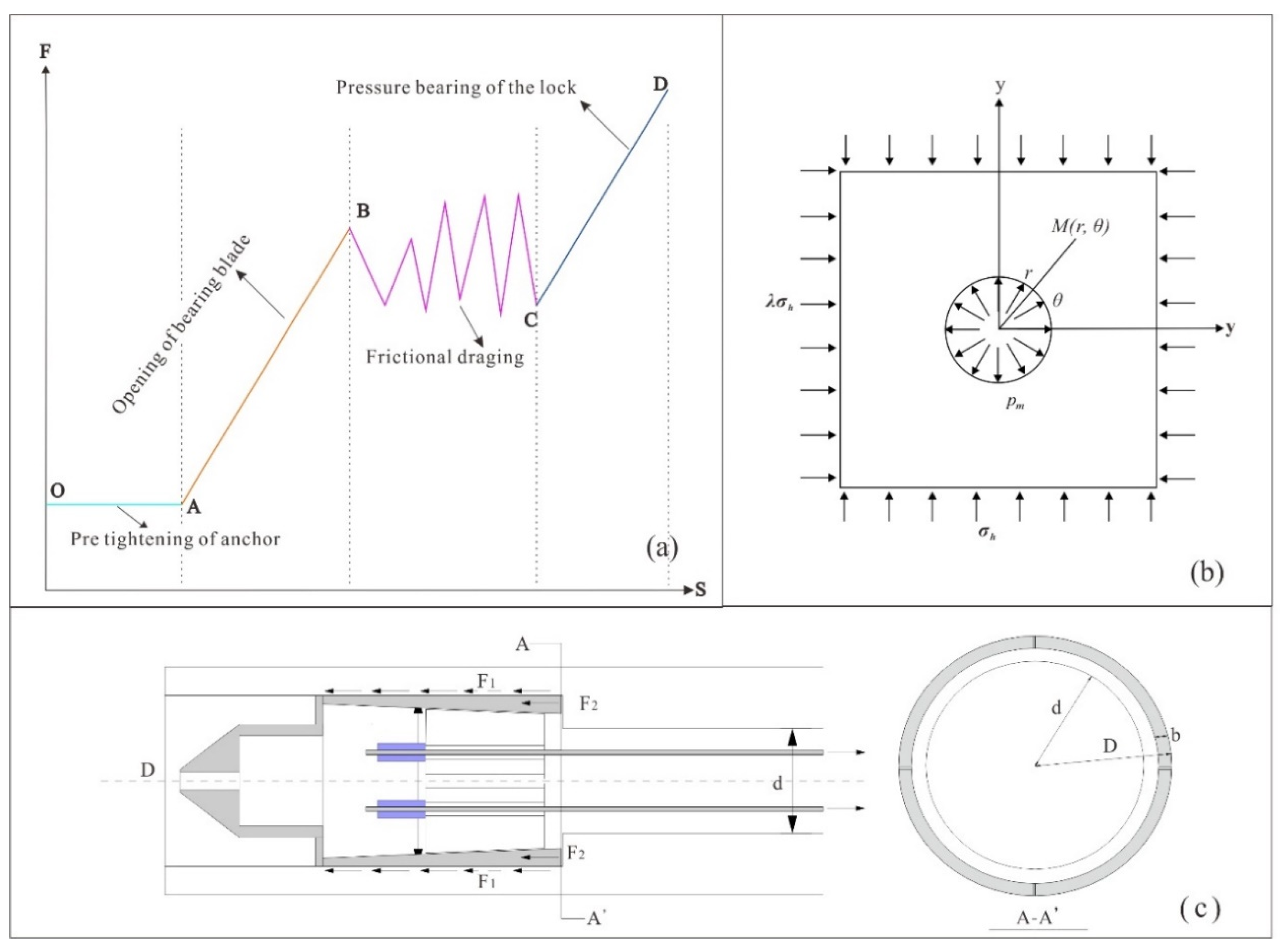
| Anchor Cable No. | Design Value of a Single Load-Bearing Body | Initial Tension | Secondary Tension | |||||
|---|---|---|---|---|---|---|---|---|
| Load-Bearing Body No. 1 | Load-Bearing Body No. 2 | Total Lock-off Load | Design Value of the MSEA | Maximum Tensile Force | ||||
| Maximum Tensile Force | Lock-off Load | Maximum Tensile Force | Lock-off Load | |||||
| 1 | 150 | 180.7 | 171.3 | 152.8 | 145.0 | 316.3 | 600 | 852 |
| 2 | 150 | 172.8 | 163.4 | 172.3 | 162.4 | 324.4 | 600 | 865 |
| 3 | 150 | 191.4 | 185.3 | 138.0 | 130.0 | 315.3 | 600 | 865 |
| 4 | 150 | 175.6 | 166.5 | 164.0 | 154.9 | 320.9 | / | / |
| 5 | 150 | 175.6 | 164.8 | 166.6 | 157.2 | 321.9 | / | / |
| 6 | 150 | 183.0 | 172.7 | 151.0 | 132.0 | 304.7 | / | / |
Publisher’s Note: MDPI stays neutral with regard to jurisdictional claims in published maps and institutional affiliations. |
© 2022 by the authors. Licensee MDPI, Basel, Switzerland. This article is an open access article distributed under the terms and conditions of the Creative Commons Attribution (CC BY) license (https://creativecommons.org/licenses/by/4.0/).
Share and Cite
Yang, D.; Wang, Q.; Jiang, Z.; Yang, D. A Multi-Segment Expanded Anchor for Landslide Emergency Management. Appl. Sci. 2022, 12, 12985. https://doi.org/10.3390/app122412985
Yang D, Wang Q, Jiang Z, Yang D. A Multi-Segment Expanded Anchor for Landslide Emergency Management. Applied Sciences. 2022; 12(24):12985. https://doi.org/10.3390/app122412985
Chicago/Turabian StyleYang, Dong, Quancheng Wang, Zhaoqun Jiang, and Dongxu Yang. 2022. "A Multi-Segment Expanded Anchor for Landslide Emergency Management" Applied Sciences 12, no. 24: 12985. https://doi.org/10.3390/app122412985





